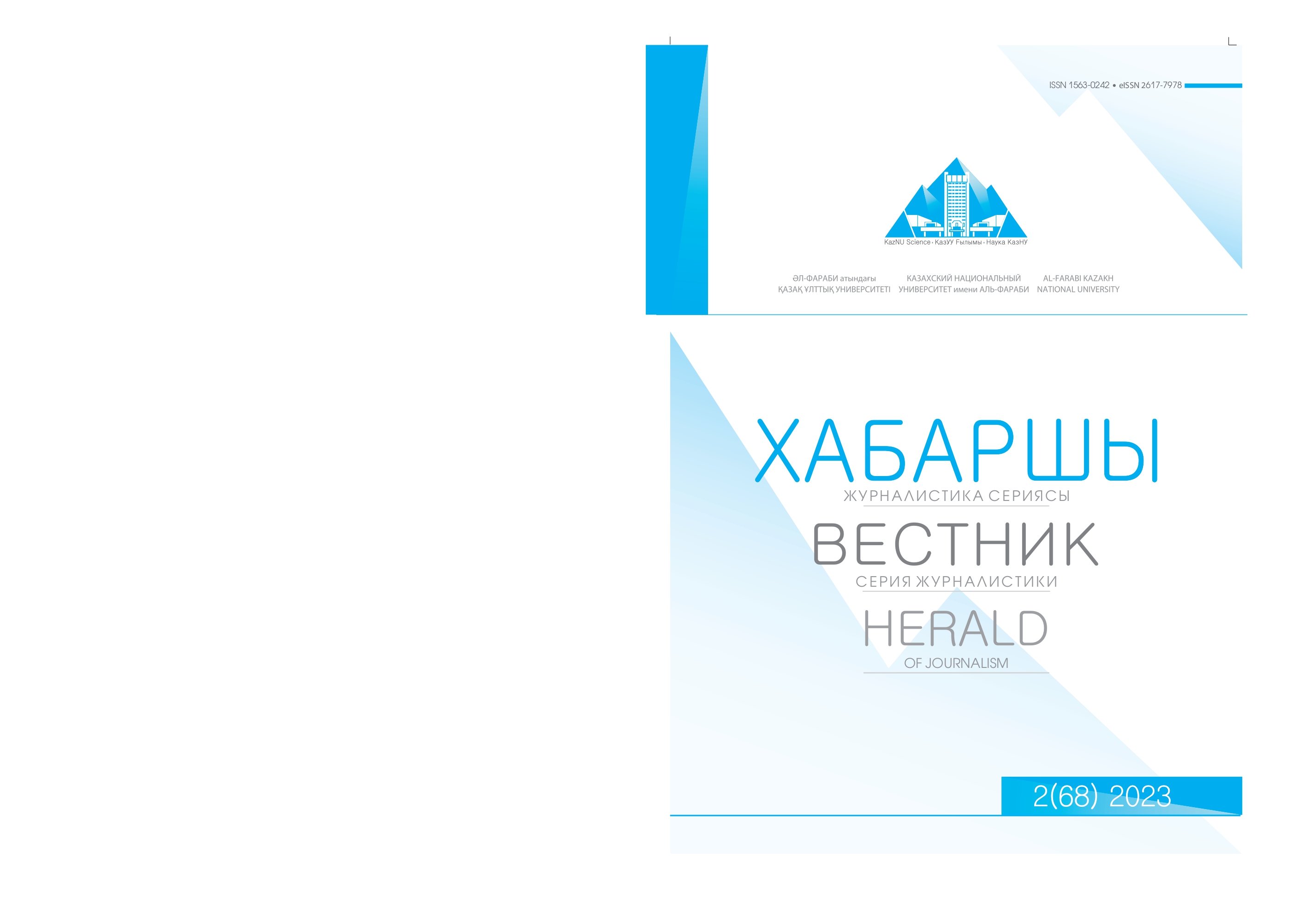About Sarah Oates and her neo-soviet media model. Preface by the scientific editor of the translation
DOI:
https://doi.org/10.26577/HJ.2023.v68.i2.02Abstract
The reader is offered for the first time the translation of Sarah Oates' program article "The Neo-Soviet Media Model", published in 2007 (Sarah Oates, 2007). In the preface by the scientific editor of the translation, the relevance of the publication is substantiated. The theoretical context of the article’s appearance is characterized, including the scientific discussion about the normative theories of media in the mid-2000s. The goal of the scientific reflection is to offer a critical eye at the research methodology of Sarah Oates, as well as a number of comments on the transformation of the Russian media system over the 16 years after the publication of the article. This article has two parts: preface by the scientific editor and direct translation of the article by Sarah Oates "The Neo-Soviet Model of Media".As annotated by Sarah Oates, the article “explores the genesis of the neo-Soviet media model. Based on the results of the study of Russian media in the post-Soviet period, as well as a review of their activities during elections in the above region, the article concludes that Russian media currently operate in a "neo-Soviet" manner. Factors shaping this media model include the rejection of a balanced approach or objectivity; the presence of flaws in the legislation regulating the activities of the media; self-censorship; state interference and pressure on the media; lack of professionalism in the journalistic environment; and an atmosphere of violence against journalists. Furthermore, in the transition from the Soviet to the neo-Soviet model, there is continuity in how the media are perceived by their audience.”
Keywords: Sarah Oates, neo-Soviet media model, media system, censorship, post-Soviet space, content analysis.
References
2. Oates S. Television, Democracy and Elections in Russia. London: RoutledgeCurzon, 2006.
3. Oates S. Revolution Stalled: The Political Limits of the Internet in the Post-Soviet Sphere. New York: Oxford University Press, 2013.
4. Оатс С. Перехватывайте нарратив // Русский журнал. 08.02.2011. Дата доступа: 12.07.2022. URL: http://russ.ru/Mirovaya-povestka/Perehvatyvajte-narrativ.
5. Sarah Oates (2007) The neo-Soviet model of the media, Europe-Asia Studies, 59:8, 1279-1297, DOI: 10.1080/09668130701655150
A reference to the preface
1. Oates S. Television, Democracy and Elections in Russia. London: RoutledgeCurzon, 2006.
2. Oates S. Revolution Stalled: The Political Limits of the Internet in the Post-Soviet Sphere. New York: Oxford University Press, 2013.
3. Zakon RF ot 27.12.1991 N 2124-1 (red. ot 01.07.2021) "O Sredstvah Massovoj Informatsii" (s izm. i dop., vstup. v silu s 29.06.2022). [The Law of the Russian Federation of 27.12.1991 N 2124-1 (ed. of 01.07.2021) "On Mass Media" (with amendments and additions, came into force on 06/29/2022)] Date of access: 12.07.2022. URL: http://www.consultant.ru/document/cons_doc_LAW_1511/. [In Russian]
4. Oates S. Perehvatyvajte Narrativ [Intercept the Narrative] // Russian Journal. 08.02.2011. Date of access: 12.07.2022. URL: http://russ.ru/Mirovaya-povestka/Perehvatyvajte-narrativ. [In Russian]
5. Sarah Oates (2007) The neo-Soviet model of the media, Europe-Asia Studies, 59:8, 1279-1297, DOI: 10.1080/09668130701655150
A reference of the original article by Sara Oates
1. Bennett, L.W. (2000). Media Power in the United States (Curran, J. & Park, M-J., Eds).
2. Curran, J. & Park, M-J. (2000). De-Westernizing Media Systems.
3. Dahl, R. (1989). Democracy and its Critics. Yale University Press.
4. Entman, R.M. (2003). Cascading Activation: Contesting the White House’s Frame after 9/11, Political Communication, 20, 4.
5. European Institute for the Media (2000a). Monitoring the Media Coverage of the December 1999 Parliamentary Elections in Russia: Final Report. European Institute for the Media. http://www.media-politics.com/eimreports.htm
6. European Institute for the Media (2000b). Monitoring the Media Coverage of the March 2000 Presidential Elections in Russia: Final Report. European Institute for the Media http://www.media-politics.com/eimreports.htm
7. Graber, D. (2005). Mass Media and American Politics (7th ed.). Congressional Quarterly Books.
8. Habermas, J. (1989). The Structural Transformation of the Public Sphere: An Inquiry into a Category of Bourgeois Society. Polity.
9. Hallin, D. & Mancini, P. (2003). Comparing Media Systems: Three Models of Media and Politics. Cambridge University Press.
10. Huntington, S. (1991). The Third Wave: Democratization in the late 20th Century. University of Oklahoma Press.
11. Hutcheson, J., Domke, D., Billeaudeaux, A. & Garland, P. (2004). US National Identity, Political Elites, and a Patriotic Press Following September 11. Political Communication, 21, 4.
12. Kachkaeva, A., Kiriya, I. & Libergal, G. (2006). Television in the Russian Federation: Organisational Structure, Programme Production and Audience. Internews Russia for the European Audiovisual Observatory. Educated Media Foundation.
13. McDonald, I.R. & Lawrence, R.G. (2004). Filling the 2467 News Hole: Television News Coverage Following September 11th. The Annual Meeting of the American Political Science Association.
14. Negrine, R. (1994). Politics and Mass Media in Britain (3rd ed.).
15. Oates, S. (2004). From the Archives of the European Institute for the Media: Analysing the Results of a Decade of Monitoring of Post-Soviet Elections. The British Association for Slavonic and East European Studies Conference, Fitzwilliam College. www.media-politics.com
16. Oates, S. (2006). Television, Democracy and Elections in Russia.
17. Pasti, S. (2005). Two Generations of Contemporary Russian Journalists. European Journal of Communication, 20, 1.
18. Schudson, M. (1995). The Power of News. Harvard University Press.
19. Siebert, F.S., Peterson, T. & Schramm, W. (1963) Four Theories of the Press. University of Illinois Press.
20. Smyth, R. (2006). Candidate Strategies and Electoral Competition in the Russian Federation: Democracy without Foundation. Cambridge University Press.
21. Sparks, C. (2000). ‘Media Theory After the Fall of European Communism: Why the Old Models from East and West Won’t Do Anymore’, in Curran, J. & Park, M-J. (eds).
22. Voltmer, K. (2000). Constructing Political Reality in Russia: Izvestiya—Between Old and New Journalistic Practices. European Journal of Communication, 15, 4.




